Our Favorite Rio Hotels
• 5-Star Hotel: Copacabana Palace
• Boutique Hotel: Villa Paranaguá
• Cheap Hotel: Copacabana Best Deal
• Family Hotel: Vila Galé
• Best Pool: Fasano
• With Private Pool: Casa Geranio
• Near Airport: Linx

Beautiful Ipanema Beach, with its iconic patterned promenade, is one of the best places to stay in Rio de Janeiro. At Ipanema, we recommend Hotel Fasano.
Brazil’s most famous city, Rio de Janeiro is a true stunner of a city in a remarkable setting, among soaring peaks that rise from the ocean. It is home to iconic sights such as the Christ the Redeemer statue, Sugarloaf Mountain, and the famous Copacabana and Ipanema beaches. The city is also famous for its vibrant samba-infused nightlife and the globally celebrated annual Carnival. Beyond these well-known attractions, Rio’s historic city center offers a wealth of treasures, including cool architecture, premier museums and art galleries, and top-notch restaurants.
Rio de Janiero Neighborhoods
The historic and commercial heart of Rio is known simply as Centro, a large rectangular grid of streets running from Guanabara Bay to the hills. This is where you’ll find the bulk of the city’s old churches, mansions, and palaces, as well as major museums and galleries like the Espaço Cultural da Marinha, Centro Cultural Banco do Brasil, Museu de Arte do Rio, and the Museu do Amanhã, Rio’s impressive science museum.
Lapa, best known for its nightlife, encompasses the southern end of Centro. Heading south along the bay, the adjacent neighborhoods of Glória, Catete, and Flamengo tend to attract far fewer visitors but do have a smattering of hotels and important sights like the Museu de Arte Moderna (Modern Art Museum) and Museu da República (history museum).
Santa Teresa is nested in the hills above, one of the city’s most romantic enclaves and home to its biggest cache of boutique hotels. Nearby Cosme Velho is gateway to the iconic Christ the Redeemer statue on Corcovado hill. Back on the bay, Botafogo is another primarily residential neighborhood home to the Museu de Ciências da Terra (science museum) and Museu do Índio (dedicated to Brazil’s indigenous peoples), while nearby Urca is tucked away beneath Sugarloaf Mountain, another Rio icon with jaw-dropping views from the summit.
The next bay south of Botafogo on Rio’s crinkled coastline is Copacabana, the world-famous beach neighborhood where there’s always something happening. Along with similar Ipanema and Leblon nearby, this is where most visitors choose to stay. West of Leblon, the coast is studded with white sand beaches all the way to the popular resort of Barra da Tijuca, while just inland, Lagoa Rodrigo de Freitas (a lagoon) is surrounded by a series of laidback neighborhoods that include Jardim Botânico, home of the botanical gardens.
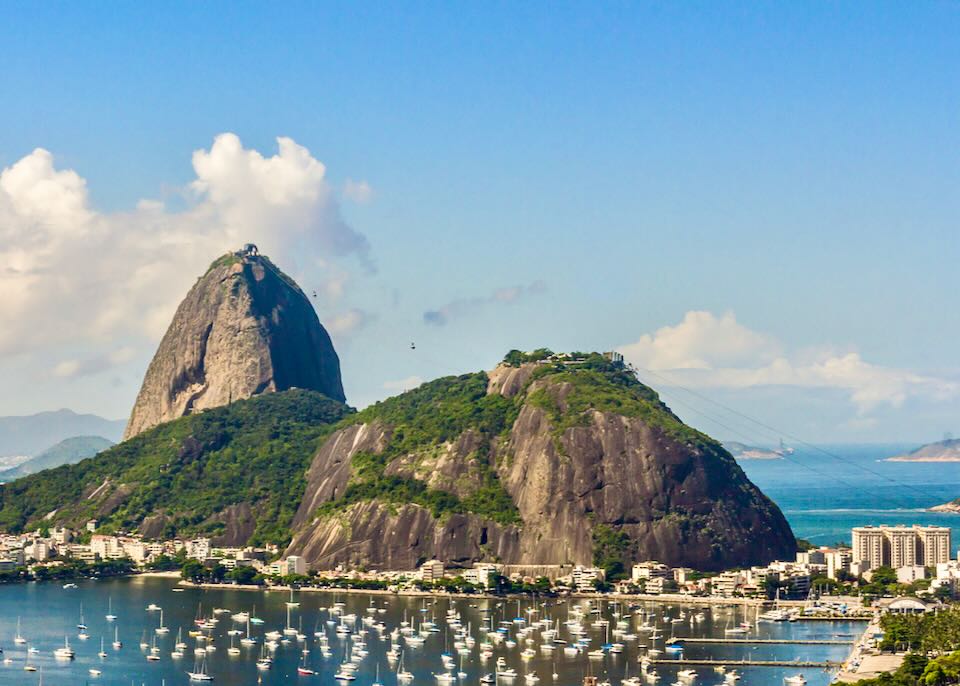
Rio’s Sugarloaf Mountain sits just north of its two most famous beaches, Copacabana and Ipanema. Departing from the Urca neighborhood, the Sugarloaf cable car makes one stop at the attractions atop adjacent Urca Hill before continuing on to the Sugarloaf summit.
Getting To and Around Rio de Janiero
Rio de Janeiro’s Galeão International Airport (officially “RIOgaleão –Aeroporto Internacional Tom Jobim”) lies 12 miles (20km) from Centro and has nonstop connections all over the world, with numerous flights to the USA, UK, Spain, Portugal, and cities across Brazil and South America. Express buses and taxis (the only choice at night) shuttle into the city. The older and smaller Santos Dumont Airport, just a few blocks from Centro, now primarily serves Belo Horizonte, São Paulo, and other Brazilian cities. It’s connected to the center by the light rail system. Given how easy it is to get into the city (by taxi, 15 min to Centro, 30 min to Copacabana/Ipanema), here’s not much point staying at Galeão. If you do need to stay here for an early departure or late arrival, Rio Aeroporto Hotel is conveniently located in the main terminal, and the more comfortable Linx Galeão is a short walk or ride away.
While it’s relatively easy to explore individual neighborhoods on foot, you’ll need to use taxis or public transport to see the whole city. Rio’s Metrô subway system is very efficient, cheap, and happily air-conditioned: it’s the best way of zipping between Centro, Botafogo, and Copacabana/Ipanema. If you’re planning to use public transport a lot, purchase a rechargeable Bilhete Único Carioca card.
Buses are also easy to use in central Rio, though they can get crowded and attract pickpockets. There’s also the relatively new light rail system (VLT) which connects Santos Dumont Airport and Praça XV to Centro and the Rodoviária Novo Rio (bus station). Taxis are reasonably priced in Rio (always insist drivers use the meter), and Uber also operates in the city.
Contrary to what you might think considering the state of its roads, Rio isn’t a bad place to ride a bike. There are around 100 miles (160km) of cycle paths connecting Centro with the beaches of Flamengo, Copacabana, and Ipanema, and continuing on to Barra da Tijuca. Bike Rio is the city’s bikeshare scheme, with 3,100 bikes and 310 stations throughout the city.
We do not recommend renting a car in Rio. Parking is difficult (and impossible to find), the one-way system is confusing, roads are congested, carjacking can be a problem in some areas at night, and local drivers rarely seem to stick to the rules anywhere in the city. Public transportation is good in Rio de Janeiro and beyond that, Uber is a safe option.
The Best Places to Stay in Rio de Janeiro
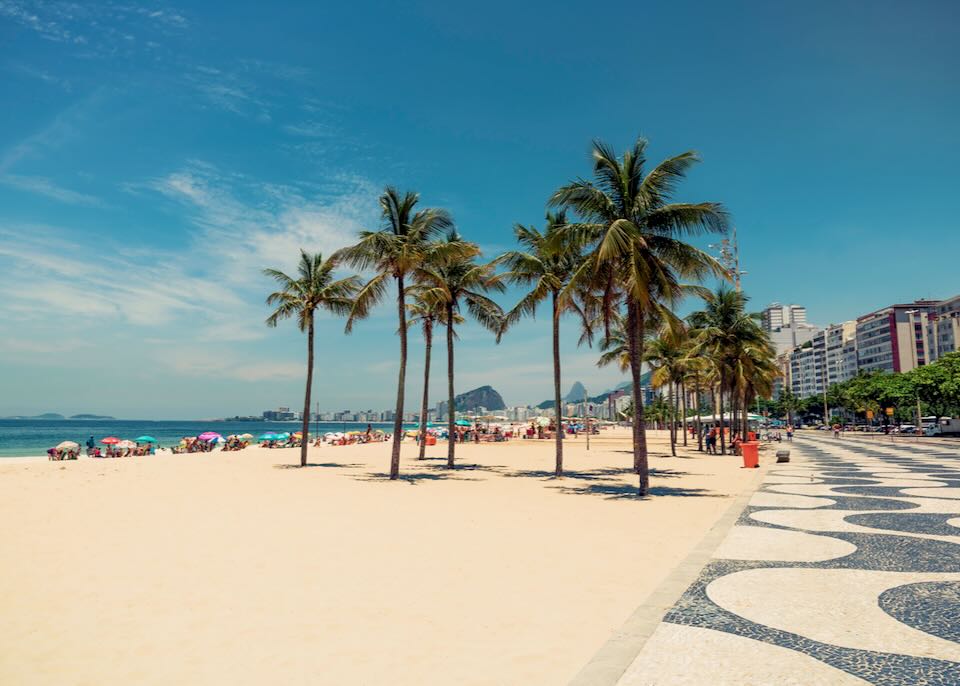
Most of Rio’s best luxury hotels are located on Copacabana Beach. We especially recommend Copacabana Palace and Windsor California Copacabana.
- Best Luxury Hotels in Rio de Janeiro
Copacabana Palace • Windsor California Copacabana • Fairmont Rio de Janeiro Copacabana • Hilton Copacabana- Best Boutique Hotels in Rio de Janeiro
Casa 48 Guesthouse • Casa Vermelha Guesthouse • Chez Georges • Rio Boutique Suites • Ritz Copacabana Boutique Hotel • Vila Santa Teresa • Villa Paranaguá- Best B&Bs in Rio de Janeiro
Casa Caminho do Corcovado • Gerthrudes Bed & Breakfast • O Veleiro Bed and Breakfast • Casa Geranio- Best Cheap & Midrange Hotels in Rio de Janeiro
Copacabana Best Deal Guesthouse • Hotel Vila Galé Rio de Janeiro • Injoy Suítes & Aparts • Windsor Copa Hotel- Best Hostels in Rio de Janeiro
Hostel Maresias do Leme • Hostel New Ipanema • Matianellu Hostel • Sangha Urbana • More Ipanema HostelBest Neighborhoods in Rio de Janeiro for…
- Best Neighborhood for First Timers: Ipanema
Rio is full of colorful, hip neighborhoods, but Ipanema is the ideal base for a first time visit to the city. It’s one of Rio’s safer, more affluent neighborhoods, with most hotels either on the seafront or a short walk from the iconic beach, always a hive of activity (the main beach boulevard closes to traffic on Sundays). Adjacent Leblon is one of Rio’s most enticing shopping hubs, and you’ll find plenty of excellent restaurants and bars all over Ipanema, meaning less need to travel further at night. When it comes to sightseeing, thanks to the metro (subway) you’ll be able to zip over to Copacabana or up to Centro (the historic center and business district), or head further west towards the beaches of Barra da Tijuca.- Best Place to Stay for Sightseeing: Centro
If the beach isn’t a priority, Centro is the best place to absorb the city’s rich history. The historic city center is peppered with baroque churches and convents, colonial Portuguese palaces and mansions, old forts, libraries, belle epoque cafés, and languid, palm-studded plazas. You’ll also be close to Lapa, the premier nightlife district, Sugarloaf Mountain, the Christ statue, and the Macaranã Stadium, the Brazilian shrine of soccer. The choice of hotels here isn’t as varied or as good as in Ipanema or Copacabana, but there are some decent budget options and a couple of better-quality hotels near the central Santos Dumont airport (Novotel RJ Santos Dumont and Prodigy Santos Dumont).- Most Romantic Neighborhood: Santa Teresa
Clinging to the slopes south of Lapa and Centro, Santa Teresa is a leafy, enchanting neighborhood of cobbled streets, “ladeiras” (steps), and gorgeous boutique hotels offering stunning views over the city and ocean below. Its bohemian vibe is maintained by a cluster of artists’ studios and galleries, and independent stores and bars. Take the aging “bonde” (tram) up from Lapa, or admire the painted tiles on the Escadaria Selarón stairway by Chilean artist Jorge Selarón. The Museu Chácara do Céu displays an eclectic collection of Brazilian and European art near the romantic Parque das Ruínas (which has a lovely café); while further up, Cosme Velho is the starting point for the cog railway up to the Christ the Redeemer statue on Corcovado. Be sure to check out the Largo do Boticário nearby, a small plaza surrounded by a picturesque ensemble of weathered, overgrown Neoclassical buildings.We like the Explorer Bar for cocktails, Bar do Mineiro for feijoada and Brazilian food, and the Mercado das Pulgas for a night of live samba at the weekends. Some of Brazil’s best boutique hotels can be found up here: Casa 48 Guesthouse, Casa Caminho do Corcovado, Casa Vermelha Guesthouse, Chez Georges, Rio Boutique Suites, Villa Paranaguá, Casa Geranio, and Vila Santa Teresa. For something cheaper try JO&JOE Largo do Boticário.
- Best Neighborhoods for Nightlife: Arco de Teles and Lapa (Centro)
It’s hard to beat Rio for overall excitement at night. Hot spots include the Arco de Teles area downtown (on Travessa do Comércio and Rua Ouvidor), and Rio’s traditional nightlife hub, Lapa (especially on Friday and Saturday nights), just to the south of the city center (Centro). Live samba and cheap caipirinhas in plastic cups, cocktail bars, nightclubs and dive bars – it’s all here. Circo Voador is a popular outdoor live venue near the Arcos da Lapa (aqueduct), while Nova Capela is our favorite old-school Brazilian restaurant and bar in Lapa. On Avenida Mem de Sá you can sample craft spirits at Casa da Cachaça before checking out the scene at the Rio Scenarium nightclub on Rua do Lavradio. Almost every Rio neighborhood boasts some sort of bar scene, especially at the weekend, with Botafogo (Rua Nelson Mandela) and Ipanema/Leblon good examples.“Caipirinha” is the most famous Brazilian cocktail, made of cachaça (sugar cane spirit), unpeeled lime, sugar and ice. Samba is big in Rio de Janeiro. Good places to see it (or join in with the dancing) include Trapiche Gamboa on Praça Mauá in Centro, and Beco do Rato and Carioca da Gema in Lapa. You can also check out the weekly samba parties (“roda de samba”) at the Pedra do Sal plaza and the “Samba da Ouvidor” in Centro. Books Hostel is a decent budget option if you want to stay close to the nightlife action in Lapa.
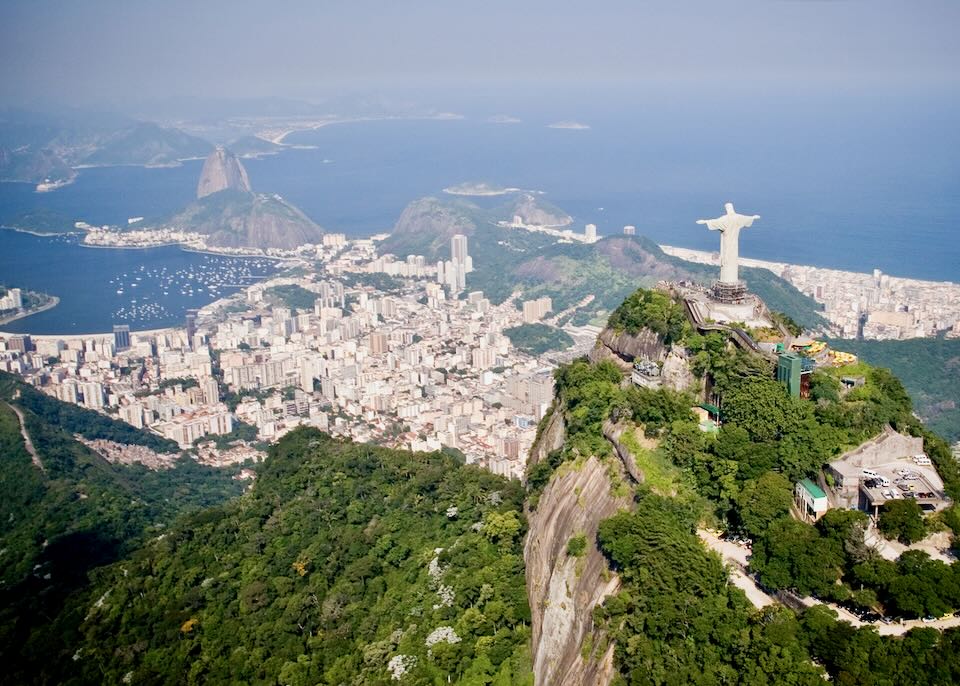
The iconic Christ the Redeemer statue overlooks all of Rio from its Corcovado Peak perch at 2,340 feet above sea level. The statue can be accessed by cog railway, departing from Cosme Velho.
- Best Neighborhood for Food and Restaurants: Botafogo
You’ll find great food all over Rio, but especially in the flourishing Botafogo neighborhood, with Ipanema/Leblon not far behind. Highlights in Botafogo include the Slow Bakery for sandwiches and artisanal breads; Liga dos Botecos for drinks and local specialties (like coxinhas/chicken croquettes); Chef Alberto Landgraf’s Oteque for a splurge; Naturalie Bistrô for high-quality vegetarian dishes; and tiny Michelin-starred restaurant Lasai for beautifully crafted tasting menus.Having a “feijoada” on Sunday is something of a tradition in Rio. The national Brazilian dish is essentially a black bean stew chock-full of different cuts of pork and beef and served with rice, “farofa” (cassava), and steamed collard greens. Casa da Feijoada in Ipanema is a good place to try it.
- Best Neighborhood for Shopping: Leblon (Ipanema)
Leblon is one of Rio’s main shopping hubs, with upscale malls like Rio Design Leblon and Shopping Leblon, and lots of stores lining leafy Avenida Ataulfo de Paiva. It’s also the safest place to shop and the easiest to navigate for first timers, close to numerous hotels and the beach. The Feira Hippie de Ipanema or “Hippie Market” (for handicrafts and souvenirs) still takes place in adjacent Ipanema on Sundays. The main shopping street in Ipanema is Rua Visconde de PirajaIn Centro, the sub-neighborhood known as Saara (around Alfândega between Rua Uruguaiana and Rua Primeiro de Março) is packed with all sorts of discount stalls and stores selling everything from jewelry to beachwear. Elsewhere in Centro, the Rio Antigo Market (antiques and flea market) in Lapa takes place every first Saturday of the month, while open-air Mercado Uruguaiana is a daily market best known for cheap clothing. The giant Riosul shopping mall is conveniently located in Botafogo, but the biggest malls are in Barra da Tijuca, further west (including VillageMall and Barra Shopping).
- Best Place for Local Vibe/to get off the Beaten Path: Urca
Though it’s pretty much in the center of Rio, facing Guanabara Bay, you’ll be surprised how few foreign tourists make it to Urca (other than rushing through on their way up Sugarloaf Mountain). This tiny enclave features a couple of small but generally calm beaches where locals swim, and the Mureta da Urca (the walled promenade), a fabulous spot to watch the sunset. For cocktails, head to Boteco Mureta da Urca; locals also hang out at Bar Urca and no-frills barbecue restaurant Bar Garota da Urca.- Best Places for Families: Jardim Botânico/Ipanema
Rio is a fun place for kids. As well as the landmark attractions such as the Sugarloaf, Christ the Redeemer statue, Copacabana beach, and soccer matches at the Maracanã, there’s the Museu do Amanhã (a futuristic science museum), a Planetarium (Museu de Astronomia e Ciências Afins), the BioParque do Rio (the city zoo), and AquaRio, a major aquarium (all in the Zona Norte or Centro).The most relaxed neighborhood overall is Jardim Botânico, best known for the playgrounds, gardens, woods, and giant koi ponds at the botanical gardens themselves, and the swan paddle boats and bikes to rent at nearby Lagoa Rodrigo de Freitas. Parque Lage is another tranquil greenspace, the former estate of industrialist Henrique Lage (his former mansion is a café). Few hotels are located here – Quarto no Jardim Botânico is one of the better exceptions. Otherwise, Ipanema lies just to the south, with a massive stock of hotels plus easy access to the beach.
Room to Roam in lush Parque Lage.
- Best Neighborhood to Stay for Beaches: Copacabana
Ipanema’s beach is fabulous, but we like Copacabana’s beach best overall. It runs for over two miles, lined with some of the most luxurious hotels in Brazil (like Copacabana Palace), but with decent budget options a few blocks inland. Its wavy-patterned promenade is a Rio icon, as are its numerous kiosks, pounding out samba beats and cocktails late into the night. The views of the surrounding mountains are stupendous, and its safe during the day (though it’s best to avoid the beach itself late at night). The white-sand beach is soft and enticing (and cleaned every day), though the water still suffers from pollution, so it’s not a great idea to swim.- Safety in Rio de Janeiro
Brazil’s reputation as a dangerous place to visit is often exaggerated, with most of the country perfectly safe to explore. Having said that, street crime in the cities can be problem, especially in Rio. Use common sense (avoid deserted streets, take licensed taxis at night, and leave expensive items at the hotel) and you should be fine. Most of the violence is drug related and concentrated in the favelas, the shantytowns that surround Rio. Needless to say, avoid all favelas unless you are visiting with locals/local guides who know the area. And on city beaches, never leave your things unattended. The best time to explore Centro is on a weekday (during the day) – it tends to get deserted and sketchy on Sundays. It’s best not to hike up the Corcovado or between Copacabana and Botafogo at any time. Copacabana and Ipanema tend to be relatively safe, but don’t stay on the beach too late.The 7 Best Places in Rio de Janeiro for Tourists
1. Centro
The central district of Rio de Janeiro, with the modernist pyramid of the Metropolitan Cathedral.
The commercial and historic core of Rio is known as Centro, a blend of Portuguese colonial remnants, Neoclassical 19th-century monuments, and modern skyscrapers. It’s not the Rio of popular imagination – there are no beaches – but if you’re interested in the history of the city (and Brazil in general – Rio was the capital until 1960), you’ll want to spend plenty of time here.
The main east-west boulevard, Avenida Presidente Vargas, runs from the waterfront to the Sambadrome, where the famed Carnaval procession takes place. Running parallel to the south is the shopping district known as Barzar do Saara, a warren of stalls selling everything from handicrafts to beachwear. Overlooking the bay at the eastern end is Espaço Cultural da Marinha (a maritime museum that houses the Galiota Dom João VI, built for the Portuguese king), Centro Cultural Banco do Brasil (a huge arts center), and nearby Igreja de Nossa Senhora da Candelária, a handsome baroque church.
North of Vargas is AquaRio, South America’s biggest aquarium, the Museu de Arte do Rio (art museum), and the Museu do Amanhã, Rio’s impressive science museum (designed by Santiago Calatrava). It’s worth strolling along the waterfront up here to view the stunning Etnias (“Ethnicities”) mural, painted by street artist Eduardo Kobra for the 2016 Olympics. Just to the south of Vargas, along the waterfront, Praça XV de Novembro is a vast square that was once the hub of old Rio and still hosts a weekly handicraft market (Thurs & Fri). The plaza features the 18th-century Paço Imperial (a cultural center housed in the former base of Portuguese colonial governors), the stately Palácio Tiradentes, the Museu Naval (charting Brazil’s naval history), the Igreja Nossa Senhora do Carmo da Antiga Sé (the old cathedral), and the beautiful church of Nossa Senhora do Monte do Carmo next door. Highlights to the west of Praça XV de Novembro include Igreja de São Francisco de Paula, another historic church, the vast and ornate 19th-century library of Real Gabinete Portuguêsde Leitura, and the Convento de Santo Antônio, the oldest church in Rio.
The southern half of Centro is anchored by Cinelândia plaza, aka Praça Floriano Peixoto, where you’ll find the elegant Theatro Municipal (modeled on the Paris Opéra), and the Museu Nacional das Belas Artes (fine arts museum). Nearby is the Museu Histórico Nacional, which chronicles Brazilian history up to the foundation of the Republic in 1889, Lapa (the city’s nightlife hub), the high-tech Museu da Imagem e do Som (dedicated to the history of music), and the Catedral Metropolitana, Brazil’s impressive modernist cathedral that towers over its surroundings like an ancient pyramid.
There are not as many hotels in Centro as you might expect – Copacabana and Ipanema are the traditional tourist enclaves – but there’s a major cluster along Av. Gomes Freire and some good deals to be had, though budget hotels in Centro tend to be poor quality. Copacabana and Ipanema are easy metro (subway) rides away from Centro.
- The Best Hotels in Centro
Novotel RJ Santos Dumont • Hotel phone: +55 21 3506-8500
Prodigy Santos Dumont • Hotel phone: +55 21 3478-4100- Best Cheap/Midrange Hotels
Fluminense Hotel • Hotel phone: +55 21 9854-70585
Windsor Guanabara Hotel • Hotel phone: +55 21 2195-6000
Hotel Vila Galé Rio de Janeiro • Hotel phone: +55 21 2460-4500
Windsor Asturias Hotel • Hotel phone: +55 21 2195-1500- Best Hostel
Sangha Urbana • Hotel phone: +55 21 99443-78802. Copacabana
Copacabana (which includes adjacent Leme) lies around 6 miles (10km) south of Centro, its world-famous 2.5-mile (4km) beach a Rio icon and host to some of the city’s best hotels. The beach is bookmarked by two historic fortresses – the Forte de Copacabana, and Forte Duque de Caxias (now both museums) – but there’s otherwise not much in the way of sights. Instead, it’s a fun place to be based, lounging on the beach by day and sipping caipirinhas in the beachside kiosks in the evenings. Handicrafts are sold along the promenade (with its famed black and white wave motif designed by renowned Brazilian landscape architect Burle Marx), while seafood restaurants line Av. Atlântica and the blocks inland.
Copacabana has a vast range of hotels, with the cheapest hostels clustered above Leme beach at the eastern end of the strip, and budget hotels a few blocks inland from the main beach. Avoid walking through the tunnels between Botafogo and Copacabana, where muggings often take place – take a bus or the metro (subway) instead.
- The Best Hotels in Copacabana
Copacabana Palace • Hotel phone: +55 21 2548-7070
Emiliano Rio • Hotel phone: +55 21 3503-6600
Fairmont Copacabana • Hotel phone: +55 21 2525-1232
Hilton Copacabana • Hotel phone: +55 21 3501-8000
Hotel Porto Bay • Hotel phone: +55 21 2546-8000
Miramar Hotel by Windsor • Hotel phone: +55 21 2195-6200
Ritz Copacabana Boutique Hotel • Hotel phone: +55 21 2187-0900
Windsor California Copacabana • Hotel phone: +55 21 2195-5600- Best Cheap/Midrange Hotels
Copacabana Best Deal Guesthouse • Hotel phone: +55 21 9793-69863
Mirasol Copacabana • Hotel phone: +55 21 2123-9292
Royal Rio Palace • Hotel phone: +55 21 2122-9292
Windsor Copa • Hotel phone: +55 21 2195-5300- Best Hostels
Aquarela do Leme • Hotel phone: +55 21 2148-4740
Maresias do Leme • Hotel phone: +55 21 9673-31847
Princess Copacabana • Hotel phone: +55 21 3936-2790
Matianellu • Hotel phone: +55 21 3936-82403. Ipanema and Leblon
Just west of the Forte de Copacabana lies Rio’s other famous beach enclave, with Ipanema blending seamlessly into Leblon to create one 2.5-mile (4km) strip. The ocean here tends to be a bit calmer than at Copacabana, though it still attracts surfers and there’s plenty of action. Like its neighbor it’s short on sights but packed with hip restaurants, bars, and boutiques (Leblon especially is known for high-end shopping). Sundays are especially fun, when the main beach road is closed to traffic and the beach is studded with sunbathers, volleyball games, and “footvolley” players.
Like Copacabana, the beach is divided into “postos”: Posto 8 is the LGBTQ section, while Posto 9 has a raffish, bohemian reputation (Feira Hippie de Ipanema or “Hippie Market” still takes place in Ipanema on Sundays inland from Posto 8). At the eastern end of the beach, the Pedra do Arpoador is the best place to view sunset; don’t be surprised if you see groups of locals erupt into spontaneous applause just as the sun goes down, a tradition since the 1950s.
West of Leblon, the coast is peppered with white sand beaches for miles, all the way to the popular resort of Barra da Tijuca (linked to Ipanema and the city via metro). En route lies Rocinha, the largest favela in Rio (best experienced on a tour with Marcelo Armstrong), and the gorgeous beach at São Conrado (popular with hang-gliders and surfers).
- The Best Hotels in Ipanema and Leblon
Hotel Fasano • Hotel phone: +55 21 3202-4000
Hotel Promenade Palladium • Hotel phone: +55 21 3171-7400
L’Homme de Rio • Hotel phone: +55 21 3586-5042
Janeiro Hotel • Hotel phone: +55 21 2172-1001
Sheraton Grand Rio • Hotel phone: +55 21 2274-1122- Best Cheap/Midrange Hotels
Ipanema Beach House • Hotel phone: +55 21 3202-2693
JM Guesthouse Ipanema • Hotel phone: +55 21 9814-07467
Leblon Ocean Hotel Residência • Hotel phone: +55 21 2158-8282- Best Hostels
Hostel New Ipanema • Hotel phone: +55 21 9682-75312
Ipanema Beach Hostel • Hotel phone: +55 21 2143-2685
More Ipanema Hostel • Hotel phone: +55 21 3556-59444. Botafogo
Rio’s Botafogo Beach boasts a beautiful view toward Sugarloaf Mountain.
Botafogo is one of the lesser-visited neighborhoods that lies on the coast between Centro and Copacabana, with a small beach at the end of a curving bay. It’s a good option if you’d prefer something a bit quieter with easy access to the rest of the city via metro. The southern side is dominated by the boats of Rio de Janeiro’s Yacht Club and the family friendly Museu de Ciências da Terra (science museum). Inland, central Botafogo is home to the enlightening Museu do Índio (dedicated to Brazil’s indigenous peoples but currently closed for renovation), the Casa de Rui Barbosa, the wonderfully preserved 19th-century home of writer and anti-slavery campaigner Rui Barbosa (1849–1923), and the Museu Villa-Lobos, which commemorates Brazilian composer Heitor Villa-Lobos (1887–1959).
The iconic statue of Christ the Redeemer is perched on top of the Corcovado (hunchback) hill to the west of Botafogo, completed in 1931 and now one of the Rio’s top sights – advance booking is essential. The views from the top are sensational and well worth the effort. Most people visit on tours or independently via the cog railway from the station in Cosme Velho (take a bus or taxi to get here).
- The Best Hotels in Botafogo
Novotel RJ Praia de Botafogo • Hotel phone: +55 21 2187-9999
Yoo2 Rio de Janeiro • Hotel phone: +55 21 3445-2000- Best Cheap/Midrange Hotels
Bambina Hotel • Hotel phone: +55 21 2539-0713
Farfalla São Manuel • Hotel phone: +55 21 98728-6799
Injoy Suítes & Aparts • Hotel phone: +55 21 99748-4343
O Veleiro Bed and Breakfast • Hotel phone: +55 21 2554-8980- Best Hostel
Gaia Hostel • Hotel phone: +55 21 3081-51085. Glória, Catete, and Flamengo
The Igreja de Nossa Senhora da Glória do Outeiro church is considered one of the finest examples of religious colonial architecture in Brazil. The church dates from 1739.
The adjacent neighborhoods of Glória, Catete, and Flamengo lie just south of Centro, and though Flamengo Beach isn’t Rio’s best, the hotels here are convenient for both the old center and Copacabana/Ipanema, and usually much cheaper. Now primarily residential and relatively affluent, these neighborhoods are busy but relaxed at night with mostly locals perusing the restaurants and bars. Major sights include the Museu de Arte Moderna (Modern Art Museum), the distinctive octagonal church of Nossa Senhora da Glória do Outeiro, and the Museu da República (former presidential residence that covers Brazilian history from 1888 on).
- The Best Hotel in Glória, Catete, and Flamengo
Windsor Florida Hotel • Hotel phone: +55 21 2195-6800- Best Cheap/Midrange Hotels
Riale Imperial Flamengo • Hotel phone: +55 21 2112-6000
Royal Regency Palace • Hotel phone: +55 21 3174-9301
Scorial Rio • Hotel phone: +55 21 3147-9100- Best Hostels
Discovery Hostel Rio • Hotel phone: +55 21 3449-0672
Por el Mundo Hostel • Hotel phone: +55 21 99527-5145
Rio Hostel 40 Graus • Hotel phone: +55 21 97668-0800
Villa 25 Hostel & Suites • Hotel phone: +55 21 3596-20696. Urca & Sugarloaf Mountain
Vermelha Beach, with Sugarloaf Mountain in the background.
Urca is a tiny enclave that occupies the headland of Sugarloaf Mountain, in between Botafogo and Copacabana – it’s surprisingly ignored by most tourists despite being one of the most attractive and well positioned neighborhoods in the city. Its two tiny beaches – Praia da Urca and sheltered Praia Vermelha – are popular with swimmers and boast a handful of hip bars and restaurants. The headland is occupied by another fortress, now the Museu Histórico da Fortaleza de São João, but the main attraction here is Sugarloaf Mountain itself, looming over all. There’s been a cable car here since 1912, but these days the modern Teleférico do Pão de Açúcar zips up to Morro da Urca (722ft/220m), where there’s a theater, restaurant, and shops, before continuing on to the Sugarloaf summit (1300ft/396m). Back on the waterfront, Mureta da Urca (the walled promenade) is a popular spot to watch the sunset with a cold beer or two.
- The Best Hotels in Urca
Hotelinho da Urca • Hotel phone: +55 21 3449-8867
Luna Rossa Guest House • Hotel phone: +55 21 97879-8826- Best Cheap/Midrange Hotel
Urca Hotel • Hotel phone: +55 21 97739-52027. Lagoa, Gávea, & Jardim Botânico
Rio de Janeiro Botanical Garden.
The Lagoa Rodrigo de Freitas, a lake linked to the ocean by a narrow canal, lies just north of Ipanema but is a lot more local and makes a pleasant break from the beach. Hotels are not great up here; it’s easiest to access the area on half day trips from Ipanema. It’s primarily residential: the neighborhood to the east is knownas Lagoa while the bairro to the west is Gávea, with the Jardim Botânico neighborhood in the middle. Other than cycling or rollerblading around the lake, attractions include the Casa Museu Eva Klabin, the 1931 home that became the base of Eva Klabin, a wealthy art collector, and the Museu Flamengo, a pilgrimage site for fans of the famous Rio soccer team Flamengo. The Jardim Botânico (botanical garden) itself is primarily a dense Atlantic forest, with monkeys, parrots, and various wildlife roaming its grounds and gardens, while horse-racing fans should check out the nearby Hipódromo da Gávea racecourse. Parque Lage is another tranquil greenspace, the former estate of industrialist Henrique Lage (his former mansion is a café).
There are not many hotels up here. Ipanema is the closest neighborhood with a wide choice of accommodation.
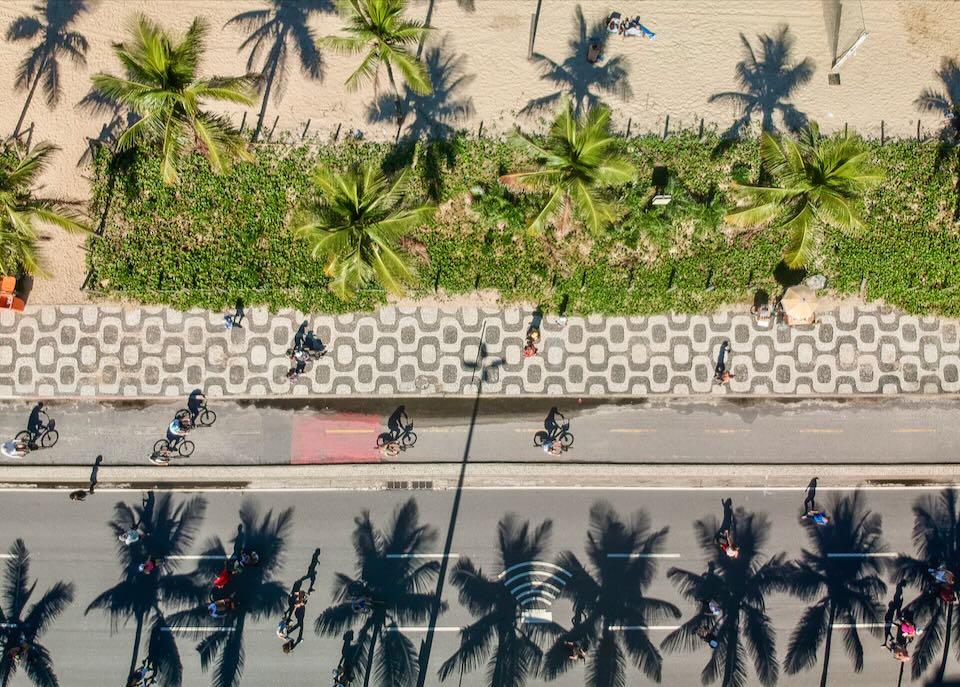
Overhead view of the famous patterned promenade at Ipanema Beach.
Rio de Janiero Travel Tips
- Though the bigger hotels and tour companies have English speakers, don’t expect most people to understand you in Rio (though staff at museums, major restaurants and tourist sites, especially younger people, will speak a bit) – try to learn a few basic words of Portuguese before you go.
- Free WiFi is available at Galeão Airport, and at cafés and museums through the city itself. You can also surf for free in Copacabana (primarily along Av. Atlântica and the beach) and Ipanema.
- The city’s main visitor office is at R. Sen. Dantas 76 in Centro.
- Tips are not mandatory in Rio, but are appreciated. Locals usually pay 10–12% in bars and restaurants.
- Carnaval (Feb/March) in Rio is a massive deal – there’s really nothing like it anywhere else in the world. Street fairs, parades, and non-stop parties essentially shut down the city for a week. Another good time to be in Rio if you like parties is New Year’s Eve, when up to two million locals gather on Copacabana beach to watch a massive firework display and dance till dawn.
- The best way to get an understanding of Rio’s infamous favelas is to take a guided tour with insider Marcelo Armstrong, who runs long-standing 3hr tours of Rocinha and Vila Canoas.
More Rio Neighborhoods
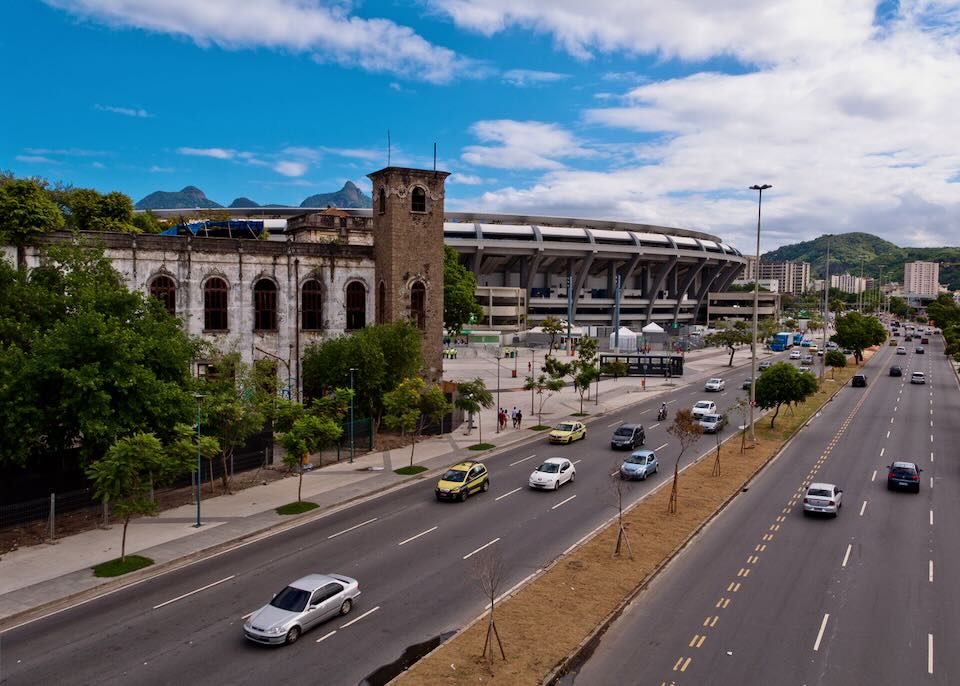
Maracanã stadium, the largest in Brazil, has a capacity of 78,838 spectators. Stadium and museum entrance (including self-guided tours) and match tickets are best purchased in advance.
We’ve covered our favorite neighborhoods to visit and stay in more detail above, but with more time there are a handful of attractions in the Zona Norte also worth checking out: Macaranã Stadium (the world’s biggest and most famous soccer stadium), the zoo (BioParque do Rio), the historic Quinta da Boa Vista park, and the Centro Luiz Gonzaga de Tradições Nordestinas, a market where you can feast on traditional dishes from the northeast of Brazil.
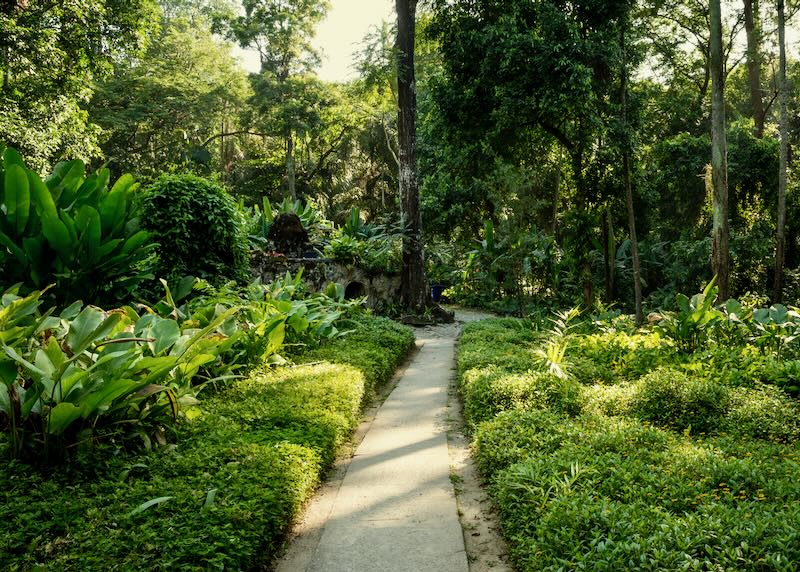

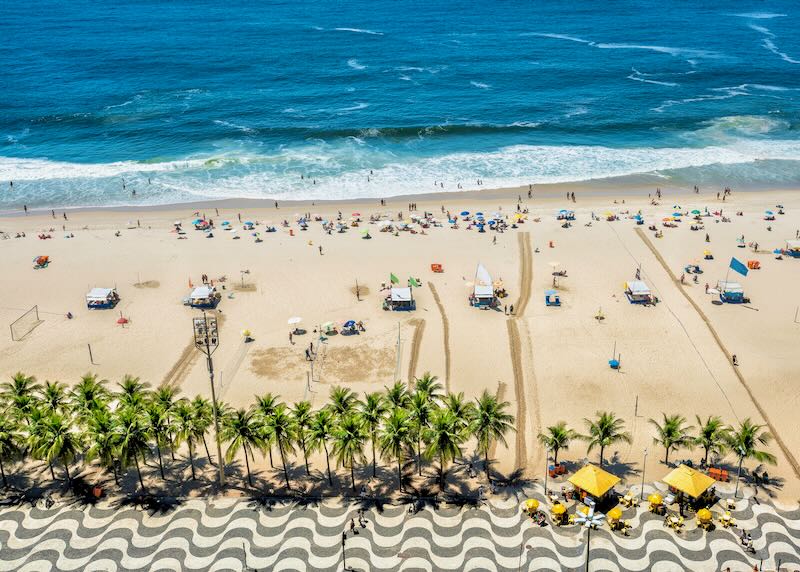
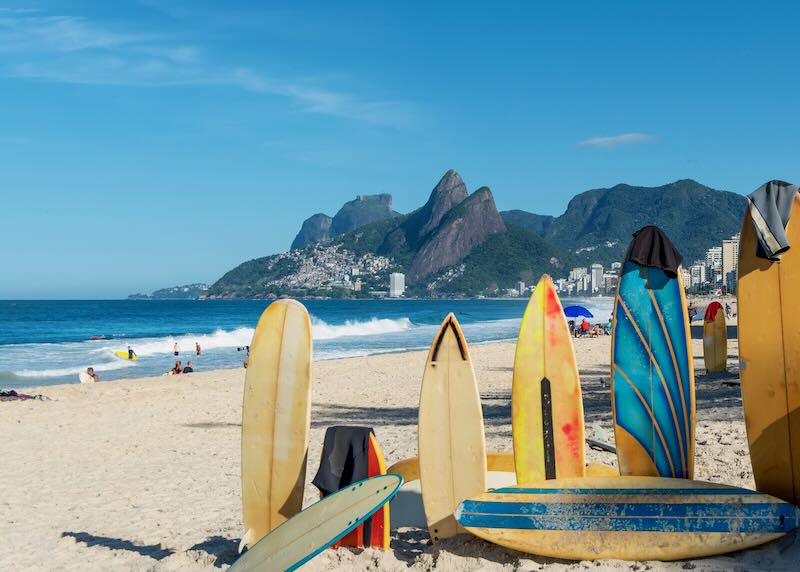
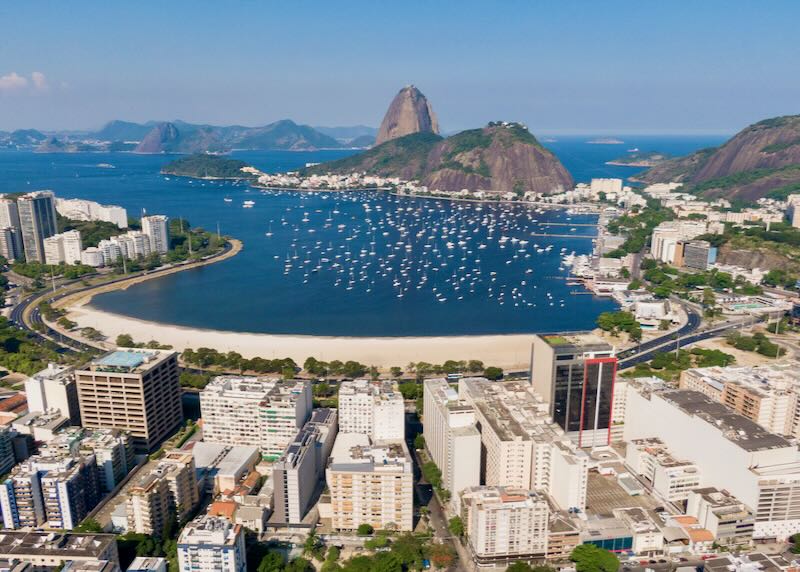
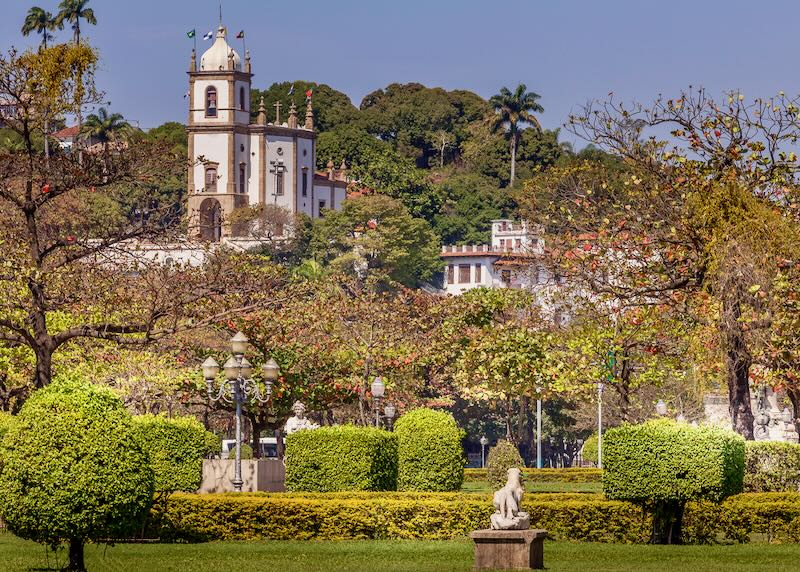
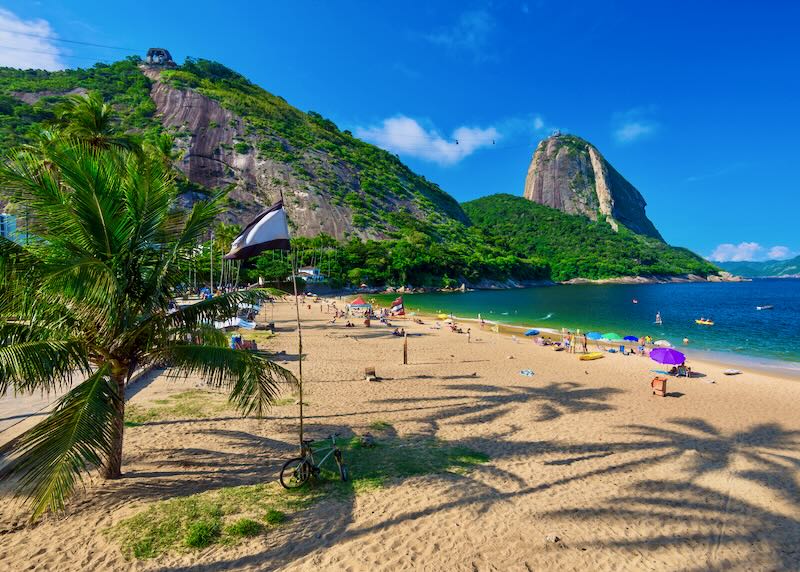
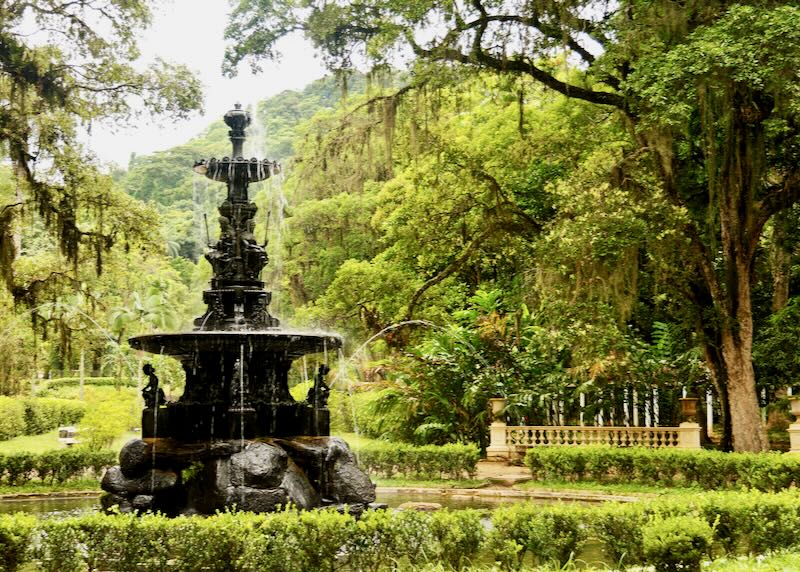
About Santorini Dave